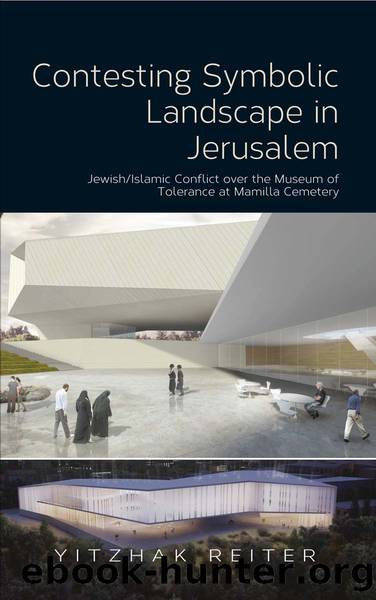Contesting Symbolic Landscape in Jerusalem by Reiter Yitzhak;

Author:Reiter, Yitzhak;
Language: eng
Format: epub
Publisher: Liverpool University Press
Published: 2014-08-15T00:00:00+00:00
Notes
1 The mass media revolution has enabled quick and widespread dissemination of the opinions (fatwas) of authorized muftis. Today one can find hundreds of new fatwas published every day in many web sites. Some important muftis have their own web sites, and there are also more general Islamic sites in which muftis issue fatwas in shifts. Some of these sites have a mufti council that issues collective responses on highly important social and political questions. During medieval times a distinction was drawn between official muftis salaried by the ruler and independent muftis. The former were organized hierarchically by provinces and districts headed by a chief mufti. On political issues the official muftis of the state will usually support the governmentâs policy while the independent muftis will challenge this policy. Today, muftis who belong to Islamist organizations issue fatwas that contradict the opinion of the state muftis and in some cases even attack these muftis. The latter are cynically termed âthe muftis of the government.â Nevertheless, the official muftis are generally more learned; they are graduates of higher educational studies at the Al Azhar Institute in Cairo or an equivalent institution, and they usually also have more legal experience than independent muftis. There are few independent muftis who can compete with the official ones. The status of the state muftis varies one country to another. See J. Skovgaard-Petersen, Defining Islam for the Egyptian State: Muftis and Fatwas of the Dar Al-Ifta, Leiden: Brill, 1997.
2 See for example S. Abu Ghosh, Qararat Sharâiyya min al-Mahkama al-Istiânafiyya, Jerusalem: Ministry of Religion, 1992, pp. 203â5 (Arabic).
3 See for example the attempt of the Supreme Muslim Council to take over the administration of the Tamimi family waqf in Hebron. The parties provided the shariâa court with two contradictory fatwas, one from Egypt and the other one from Syria. See M. Bakhit al-Mutiâi (former mufti of Egypt), Surat Fatwa âan Waqf Tamim al-Dari al-Sahabi wa-Aâqabihi, Cairo: Bulaq: Dar al-Tibaâa al-Fuâadiyya, 7 Rajab 1350 (18 November 1931) (Arabic).
4 In some Muslim states there is a state Mufti who serves as a civil servant of the ministry in charge of the shariâa courts. In such cases the ministry can impose fatwas on the courts.
5 Sawt al-Haqq wal-Huriyya, 2 January 1998, p. 19 (Arabic).
6 Y. Reiter, âManipulating fatwasâ (forthcoming).
7 Article 99 of the 1965 Planning and Building Law states, âAn instruction in any local or district zoning plan regarding the safeguarding of holy places or cemeteries will be issued in consultation with the minister of religious affairs and in case of monuments or sites that have historical and archaeological importance, in consultation with the minister of education and culture.â
8 The Khawarij is an extreme subversive sect that clashed with the fourth and fifth caliphs and nominated their own caliphs. They objected to arbitration between the caliphs Muâawiyah and âAli, and they had their own interpretation of Islamic law. The Shiâites view Ali ibn Abu Talib, prophet Muhammadâs cousin and husband of the prophetâs daughter Fatima, as Mahammedâs sole heir.
Download
This site does not store any files on its server. We only index and link to content provided by other sites. Please contact the content providers to delete copyright contents if any and email us, we'll remove relevant links or contents immediately.
The Five People You Meet in Heaven by Mitch Albom(3450)
Real Sex by Lauren F. Winner(2947)
Name Book, The: Over 10,000 Names--Their Meanings, Origins, and Spiritual Significance by Astoria Dorothy(2921)
The Secret Power of Speaking God's Word by Joyce Meyer(2898)
The Holy Spirit by Billy Graham(2860)
0041152001443424520 .pdf by Unknown(2748)
ESV Study Bible by Crossway(2720)
How The Mind Works by Steven Pinker(2709)
Ancient Worlds by Michael Scott(2603)
Churchill by Paul Johnson(2489)
The Meaning of the Library by unknow(2483)
The ESV Study Bible by Crossway Bibles(2476)
The Gnostic Gospels by Pagels Elaine(2450)
MOSES THE EGYPTIAN by Jan Assmann(2356)
Jesus by Paul Johnson(2288)
City of Stairs by Robert Jackson Bennett(2276)
The Complete Dead Sea Scrolls in English (7th Edition) (Penguin Classics) by Geza Vermes(2214)
Ancient Near Eastern Thought and the Old Testament by John H. Walton(2179)
The Nativity by Geza Vermes(2160)
